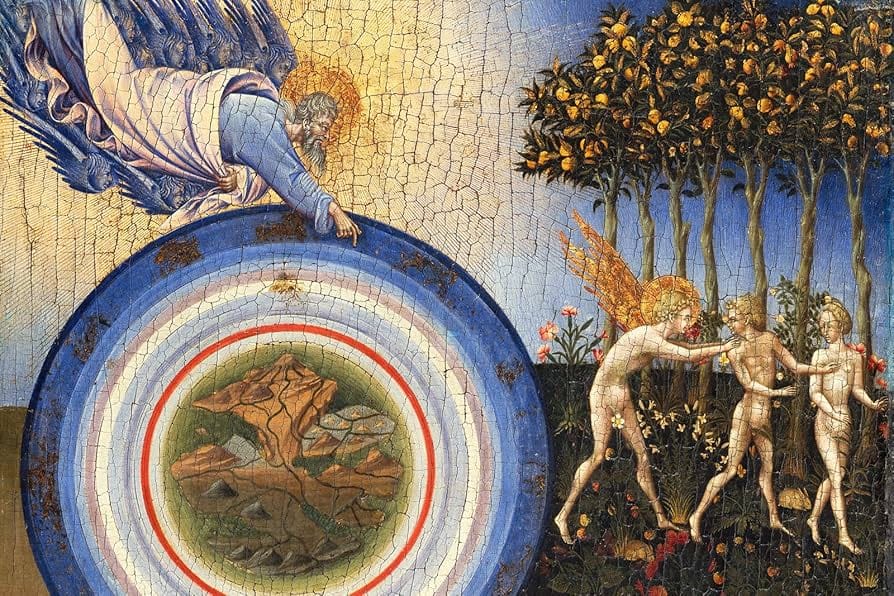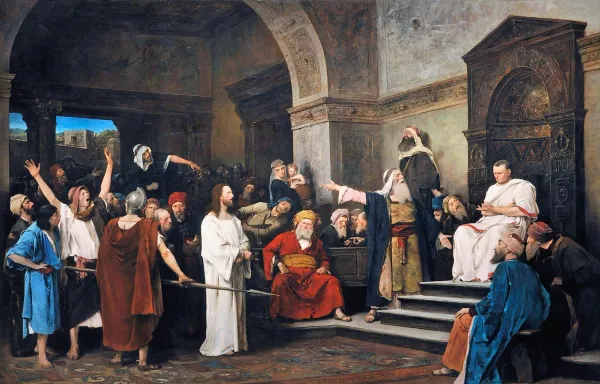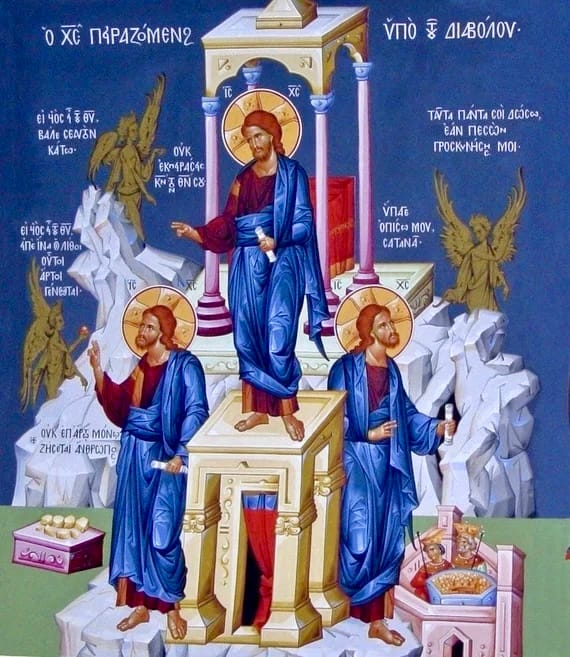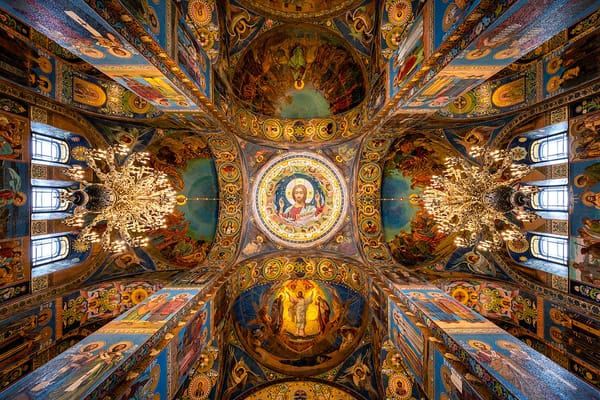Fathers, Sages and the Book of Creation: Reading Genesis with Nahmanides
Nahmanides had success salvaging certain pre-Maimonidean currents of Jewish exegesis while seeking to set them on a new comparatively more systematic basis.

It may be of interest to note that in the comprehensive commentary on the Torah written by a great mystic of the thirteenth century, Moses Nahmanides, there are many symbolical interpretations as defined here, but not a single instance of allegory.1 ~Gershom Scholem
The account in Genesis (Bereshit) of God's creation of man in his cosmos is pivotal for countless reflections on the meaning of human distinctiveness by Jews, Christians, and others. In its distillation of the insights of the very particular experience and self-fashioning of Hebrew civilization as well as its elevation of these to the level of what has been received as a universal archetype, much is it stake in reading this narrative well. The faithful exegete concerned with the history of ideas and their present as well as future import, will not be content with even the most exhaustive genealogy of Scripture's textual production and transmission or the most unsparing analysis of its constituents to disclose parallels with broader trends in Near Eastern thought. He or she can benefit from these methodologies while retaining an overall commitment to securing the coherence of the symbolic world enacted in communal rituals of sanctification that encompass every dimension of life within a liturgical consciousness foregrounding reverence for the divine.
In this essay, after illustrating some of the halakhic principles that differentiate Nahmanides from the axial figure of Maimonides and how they shape his entire mystical hermeneutic, I will focus on Nahmanides's approach to the doctrine of creatio ex nihilo in Genesis and certain anthropological-eschatological implications that arise from it in his way of understanding Adam. In my view, he had notable success salvaging certain pre-Maimonidean currents of Jewish exegesis while seeking to set them on a new comparatively more systematic, though still imperfectly systematic, basis; and this was by design rather than by error. He resisted the thoroughgoing rationalization of obscure aspects of the Jewish self-narrative and legal régime through the calculated use of obscurity that safeguarded the interpretive authority of the sages from overly invasive scrutiny. His effort to reimagine the syntax of Jewish faith while preserving as much of its grammar as possible was so successful that his methodology still defines major currents of rabbinic praxis today. Perhaps no text better exhibits his genius in microcosm than his exegesis of Genesis (Bereshit).
Genesis establishes the generative grammar of the relationship between God, man, and world. As Nahmanides states, the doctrine of divine creation ex nihilo is "the root of faith" and "he who does not believe in this and thinks the world was eternal denies the essential principle of […] religion and has no Torah at all."2
In making this statement, Nahmanides firmly endorses a mainstream rabbinic position. However, since creatio ex nihilo is not straightforwardly evident from a reading of the bare text of Genesis, which seems to begin with an act of divine formation of primordial chaos (tohu wa-bohu) rather than depicting the emergence of being as such from nothingness, it will be helpful to see what precedent exists for this position in prior literature to which Nahmanides would have had access. As Simon Oliver observes, summing up the three possible philosophical views of creation from among which Sara Klein-Braslavy argues Maimonides declines to choose (taking the stance of "a skeptic who maintained epoche"),
In the background to creation ex nihilo, we can […] see three alternative views of creation. First, we have the Aristotelian view that the universe is of everlasting time and sits alongside God mirroring his eternity. Secondly, we have the constructivist view, apparently seen in Plato’s Timaeus, in which a demiurge makes the cosmos from pre-existent material. Having no ultimate beginning or origin, this pre-existent material chaos always sits alongside God. Thirdly, we have the emanationist view in which creation emerges from God by necessity, like the stream from the spring, albeit without a temporal beginning.4
Turning to the Biblical text, Gary Anderson notes, "[t]he two most commented-upon texts are Genesis 1:1 and 2 Maccabees 7:28." Whereas the former is ambiguous, and indeed Anderson notes that "the consensus among scholars (with which [he] agree[s]) is that the first three verses depict God forming the world out of preexistent matter," the latter proclaims, "Look at the heaven and the earth and see everything that is in them, and recognize that God did not make them out of things that existed." Anderson acknowledges, however, that this statement still leaves open the possibility that God formed them from unformed matter, citing the use of "an almost identical idiom to describe the engendering of children by their parents." He concludes that "this text fails as a decisive prooftext for the doctrine. The most we can say is that 2 Maccabees is patient of the doctrine of creatio ex nihilo."5
Anderson stresses how, based on the way Biblical authors stress the subversion of prior creation narratives (especially the Babylonian Enuma Elish), the central point is that God created unopposed. In their conceptual grammar they could not have been aware that, for the Greeks,
the eternity of matter implied that the gods [or God] were constrained by its limitations when they created the world. […] If we were to sit down with our priestly scribes and give them a brief introduction to Greek cosmology,
emphasizing for them the fact that preexistent matter necessarily restricts what God can accomplish in the material world, can we imagine that they would accept such a notion? Though certainty obviously alludes [sic] us, I find it hard to imagine.6
While the most Anderson can say is that "Genesis 1 does not teach creatio ex nihilo […but] does not rule it out as decisively as many modern readers have assumed,"7 Menahem Kister carefully analyzes ancient interpretations of "tohu wa-bohu" and traces "the emergence of the theological notion according to which the world was not created out of primordial elements."8 Kister stresses how, even in accounts that regard tohu wa-bohu as "at the foundation of creation," "These primordial elements may or may not be the ‘chaos’ of Hellenistic speculations."9 He notes that it is thanks to Philo, drawing on a prior concern of the Book of Jubilees, that the move of explicitly inferring God's creation of the primordial elements despite the lack of scriptural comment on this point became more mainstream and preeminent. One way this occurred was, of course, through the extensive reception of Philo by the Christian Church Fathers. In an expression of humility, however, Kister prescinds from answering the questions of whether "there [was] a doctrine of creatio ex nihilo in ancient Judaism; and if there was […], when and in which circles it emerge[d . . . and h]ow it [was] related, if at all, to the emergence of this doctrine in Christianity," conceding that "It is very difficult, probably even impossible, to answer these questions appropriately."10
Another traditional rabbinic question considers why the Pentateuch should begin with a creation account at all. While the importance of the foundational moment of Moses at Sinai would be evident to the halakhic exegete, because it occurs within what he takes to be recorded history and grounds the written as well as oral Torah that governs the life of the Jewish community, less evident is the need to extend the narrative backward to the misty origins of things before any human could have been present to bear assenting witness and record them. The response given in Midrash Tanhuma,11 that the purpose of Genesis is to provide Jews "with scriptural proof that the world humans inhabit was exclusively the domain of God, who could therefore give it to whomever he pleased"12 (cf. Bereshit Rabbah, "Are you not a nation of robbers? […] The world and the fullness thereof belong to the Holy One, blessed be He. When He willed it, He gave it to you, and when He willed it, He took it from you and gave it to us."13), is judged by Nahmanides necessary but insufficient. For by his day the philosophers believed they had parted the veil enough to disclose the structure of the cosmos. Maimonides even went so far as to equate "the work of Genesis" (Ma’aseh Bereshit) with what was in his day the state of the art in natural philosophy as disclosed to Arab, Christian, and Jew alike through Aristotelian physics and metaphysics.14 What, then, would remain for Israel as the chosen people of God as their own trust, when even the innermost secrets of revelation could be pierced by enlightened reason?
Nahmanides delivers the master stroke of hieratic history against the impudence of reason. As Moshe Halbertal suggests, "Had Maimonides not defined his approach to these questions against those of the Geonim who preceded him, perhaps Nahmanides would not have taken notice. His devotion to defending the Earlier Authorities required him to craft his own systematic perspective that could hold its own against the one Maimonides set forth in the prefatory Principles to his Sefer ha-Mitzvot."15 Halbertal stresses that this was no mere recapitulation of the earlier authorities, however: "The three put forward different, incompatible theories of the fundamental concepts of the halakhic system."16
It is important to understand why Nahmanides perceived that the Geonic approach was no longer sufficient post-Maimonides. The approach of "the Geonim bases the authority of the entire halakhah in the revelation at Sinai. The explanation given for controversy, however, undermines the reliability of the transmitted tradition."17 Everything that was given at Sinai to Moses is reconstructed with by Geonic authorities but the further from the source of the chain of transmission the lesser the authority. Maimonides could not accept this "restorative approach," because he feared it made the transmitters appear incompetent. His solution was to argue "in opposition to the Geonim, that the Sinaitic revelation did not include all the normative contents of the halakhah. Significant portions of halakhah have been generated by human interpretive activity."18 Instead of the Geonic position that "halakhic knowledge had started out perfect and complete," Maimonides argued that "not only does halakhic knowledge not deteriorate, it in fact accumulates over time."19
The upshot is that, because so much of the previous rabbinic tradition is founded not on an exhaustive revelation but the exercise of reason, interpreters in one’s own day and in the future can reason as well or even better than those earlier in the chain. "At every point in halakhic history the same revealed knowledge is present, so no point in time can be privileged solely on the basis of chronological considerations."20 Maimonides chooses to limit the scope of what was revealed at Sinai to the Jewish canon as it has been handed down intact to preserve its credibility and enable more daring exegesis in an attempt to restore an oral tradition that, if it existed, has become lost anyway. "Maimonides strove to isolate the Mosaic revelation from the rest of the corpus as an immutable, undisputed, adamantine kernel of unmatched halakhic status."21 He uses philosophical reasoning to fill in the gaps but "tries to protect the kernel from those who would presume to speak in its name through the interpretive act."22
Nahmanides, by contrast, "is able to envision the entirety of halakhah within the divine word because he has a more expansive understanding of revelation."23 The Torah was disclosed not only once and for all at Sinai in the same form available to us now, as Maimonides insisted against the Geonim, but "preceded the creation of the world, and, needless to say, it preceded the birth of Moses our teacher […] it was written with letters of black fire upon a background of white fire."24 Citing the rabbinic practice that "a Scroll of the Torah in which a mistake has been made in one letter’s being added or subtracted is disqualified [even though the literal meaning remains unchanged," he stresses how this signifies the principle "that the whole Torah comprises Names of the Holy One blessed be He."25 While Nahmanides invokes this tradition as a defensive posture against the radical readings of philosophers like Maimonides, hanging on the rabbinic precept of "do not deviate," Halbertal stresses how his own hermeneutical move is if anything more profoundly radical at least potentially:
The most basic unit of Scripture that is not subject to change is not the word but the letter and its location within the long string of letters. This idea deeply undermines the text’s stability and is fraught with antinomian potential, because the biblical text becomes dynamic, showing a different face each time the sequence is parsed in a different manner.26
According to these hermeneutical principles, wherein the Torah and the Law were "given to Moses our teacher using the division of words which expresses the commandment, and orally it was transmitted to him in the rendition which consists of the Divine Names,"27 not just anyone could replicate the efforts of the sages nearer to the moment of revelation in time and space but only those privy to the secret keys entrusted from God to Moses, passed down by oral tradition from mouth to mouth. As Halbertal makes plain, "The Sages do not expose the meaning of revelation, they constitute it […] The Torah, in this imagining, has no meaning independent of that which the Sages impart to it."28 And Maimonides, of course, lacked this tradition. Why else would he be so befuddled and irate at not only the common man’s scripturally sanctioned anthropomorphism of God, spilling so much ink against it in his Guide for the Perplexed?29 Were these rich imaginal elements merely an embarrassment to the science of divine simplicity or a product of divine condescension to the primitive condition of man’s intellect in cruder eras?
For Nahmanides, the only way to defend the honour of the Talmudic sages and ultimately God himself was for the mythic to return to post-philosophic consciousness with a difference that preserved its value as well as that of philosophical inquiry in a higher key. The inexplicable or trivial detail is so only from the standpoint of a limited mentality not privy to the correspondence of the world below to worlds above. In this way, he safeguards the concern of Ashkenazic exegesis like that of Rashi for access to the plain literal sense (peshat) without leaving his hands tied when facing an Aristotelian like Maimonides or an astrologer like Ibn Ezra. The extrinsically closed yet intrinsically open kabbalistic frame afforded a suppleness that could not be stymied by any attempted reduction to this system or that. As Halbertal notes, Nahmanides's attempt
to include the entire halakhic system in the primary revelatory event [. . . gives rise to an] idea of revelation as multifaceted and encompassing the entire body of halakhic norms, and of interpretation as an ongoing revelation that constitutes meaning by selecting the normative one from a plethora of other options.30
In a manner that appears strikingly contemporary, Nahmanides declines to reduce the text to what is on the page and accessible to all equally. The oral traditions, both those written down and those left unwritten, are also part of the text. The embeddedness of the text in communities of practice is also part of the text. The faith of the exegete and his relative distance or proximity to the matters it treats are part of the text. None of these are optional extras: without the mystical meaning (sod), there is no literal meaning (peshat), for "interpretations according to peshat and sod appear neither to parallel or conflict with each other, but rather they seem linked in a material sense, such that an understanding of the former leads to an understanding of the latter."31 As Wolfson notes, citing Bernard Septimus, "Nahmanides advanced the Andalusian conception of peshat ‘by broadening the conception of interpretation to include rabbinic, halakhic, and aggadic, as well as kabbalistic, modes of explanation."32 In these ways Nahmanides positions himself in ways that offer compelling parallels to the post-critical Biblical exegesis called by for modern scholars like Matthew Levering ("participatory Biblical exegesis").33 While his foil is not modern historical-critical Bible scholarship that renders horizontal-sequential what metaphysical theology had rendered vertical-simultaneous in a manner similar in Maimonidean as in Thomistic philosophy, he shares with his postmodern counterpart the same objective: the disclosure of the participatory-historical as a narrative capable of mastering every other.
Having proclaimed the doctrine of creatio ex nihilo as indispensable where Maimonides left the matter ambiguous,34 Nahmanides uses etymological analysis, "demonstrating that 'to make' (laasot) represent[s] something separate from 'created' (bara)"35 to restrict its proper referent to the initial creation of the heavens and the earth (ha-shomayim ve’et ha-aretz).
The Holy One, blessed be He, created all things from absolute non-existence. Now we have no expression in the sacred language for bringing forth something from nothing other than the word bara (created). Everything that exists under the sun or above was not made from non-existence at the outset. Instead He brought forth from total and absolute nothing a very thin substance devoid of corporeality but having a power of potency, fit to assume form and to proceed from potentiality into reality. This was the primary matter created by G-d; it is called by the Greeks hyly (matter). After the hyly, He did not create anything, but He formed and made things with it, and from this hyly He brought everything into existence and clothed the forms and put them into a finished condition.36
This allows him to save the appearances of the philosophers' account of transformations in primordial elements or matter (hyle) while circumscribing it within a prior act of divine will that is utterly free and gratuitous, safeguarding divine sovereignty as well as the interpretive authority of those who resist allegory. Unlike the rabbinic accounts surveyed previously, he also does not have to draw on any terms not explicitly said by the literal word of Scripture to have been created by God as the heavens and the earth clearly are. "Know that the heavens and all that is in them consist of one substance, and the earth and everything that is in it consist of one substance. […] they alone were created, and everything else was constructed from them."37 This also enable him to make sense of the phrase "The earth was without form and void (tohu wa-bohu)" by equating tohu with formlessness and bohu with a thing which has substance, citing a Midrash of Rabbi Nechunya ben Hakanah in which he cites Rabbi Berachya to analyze the latter word as a "composite of the two words [. . .] ‘bo hu’ (in it there is substance)."38 Thus, creation in the proper sense (bara) is strictly distinguished from other verb forms that designate formation.
This also has implications for anthropology, because when the verse says, "Let us make man in our image and likeness," the referent of the us is not as many Christian exegetes supposed the Trinity, nor is it God and the angels or, as historical-critical readings speculate, a vestige of henotheistic monolatry that acknowledges the presence of multiple gods even while the God of Israel maintains his hegemony. Instead, what is meant is that man, unlike every other creature on earth, is formed from both the celestial or divine and the terrestrial or mundane:
[I]n the case of man He said, Let us make, that is, I and the aforementioned earth, let us make man, the earth to bring forth the body from its elements as it did with cattle and beasts, as it is written, And the Eternal G-d formed man of the dust of the ground, and He, blessed be He, to give the spirit from His mouth, the Supreme One, as it is written, And He breathed into his nostrils the breath of life. And He said, In our image, and after our likeness, as man will then be similar to both. In the capacity of his body, he will be similar to the earth from which he was taken, and in spirit he will be similar to the higher beings, because it [the spirit] is not a body and will not die. In the second verse, He says, In the image of G-d He created him, in order to relate the distinction by which man is distinguished from the rest of created beings. […]39
The care Nahmanides takes in countering the philosophical position that this composite nature of the human being means his nature is inherently mortal ensures that protology is able to underwrite eschatology. Whereas "according to the opinion of the naturalists (anshei ha-teva), man is subject (me'uttar) to death from the beginning of his formation (ha-yetsirah) because he is composite […] the determination of death is in the hands of God […] [human beings] must die because of their sin before their time. [CT: Gen. 2:17 - I, 37]"40 Nahmanides makes clear that "in the opinion of our Rabbis, if Adam had not sinner, he would have never died, since the higher soul bestows life forever, and the Will of G-d which is in him at the time of his formation would always cleave to him and he would exist forever."41 Since it was only due to sin as a divergence between divine and human will that death became man’s fate, the overcoming of this divergence in the age to come will not be a form of supernatural grace extrinsic to his nature but a restoration of his originally immortal nature lost through the Fall:
Before eating the fruit, "Man did by nature what he should have done according to generation (kefi ha-toledet), as the skies and all their hosts do, 'true workers because their work is truth and they do not change their role,' without having in their actions either love or hate. On the other hand, the fruit of that tree is that which causes to be form in them that eat it the will and the desire to choose something or its opposite, for good or for evil." The fall is like a degradation, a passing from the level of natural obedience to the level of deliberate choice, a choice that includes the possibility of a preference for evil.42
This shift is reflected in his mode of sustenance, for initially Adam had been nourished by the light of God and "it is possible that the fruits of the garden of Eden were absorbed in his limbs as the Manna […] when He decreed upon him, And thou shalt eat the herb of the field and with the sweat of his face he shall eat bread of the earth, this [the food] became a cause for decomposition since he is dust, and dust he eats, and unto dust he shall return."43 In the age to come, the glorified body of the righteous who cleave to God will be once again nourished by this subtler divine sustenance. Nahmanides sees a recapitulation of the prelapsarian state in Moses:
For the soul subsists by uniting with the Supernal Intellect, just as the angels subsist through it. The transcendence of the soul over the body nullifies the faculties of the body […] until the body, like the soul, can subsist without food or drink, as Moses subsisted for forty days o the mountain.44
Nahmanides also makes skillful use of the Fall to defend the fittingness of the Jewish communal practice of mourning. For the naturalist philosophers, death is something natural and so it is irrational to be upset by it. Yet as Nahmanides insists,
The reason for commandments about the dead is that humans were created to live forever. Only because of sin did death intervene between creation and resurrection in the world to come. So mourning is in reality for the presence of sin and its deadly effects in the world: For man's original destiny (toldat ha-'adam) was to live forever, but through the primal sin (he-het ha-qadmoni) all became mortal... That is why it is right for us to understand mourning as an act of worship of our God. [KR: Torat ha-'Adam: intro. - II, 12]45
Yet although Nahmanides makes use of the Hebrew equivalent of "original sin," he does not follow the Augustinian reading that conflates “physically inherited mortality” with "actual moral taint. […] Despite our inherited mortality, sin itself is an individual responsibility."46 This distinction bears strong resemblances between the contrast between "original sin" and "ancestral sin" drawn by certain Eastern Orthodox polemics against Western Christian understandings, e.g. that of John Romanides.47 Interestingly, the Augustinian doctrine would be a key point in the famous Disputation of Barcelona in 1263 in which Nahmanides publicly defended the rabbinic Jewish position against the Dominican Friar convert from Judaism Pablo Christiani:
It would be outrageous (halilah) for God if the righteous were to be punished in Hell because of the sin of the first man, their father — that my soul should be akin to the soul of Pharaoh, as it is to the soul of my own father! My soul will not enter Hell because of Pharaoh's sin! But bodily chastisements arise because my body stems from my father and mother. And when it was decreed that they [Adam and Eve] should be mortal (benei mavet), their descendants thenceforth were made mortal by nature. [KR: Disputation, sec. 45 - 1, 310]48
This engagement highlights how Nahmanides’s account of human nature’s fall and redemption through Adam was formulated in a Christian Iberian context proximate to France where he could draw judiciously on the useful hermeneutical insights from Christians without transgressing the disciplinary boundaries of his own Jewish community. In our contemporary era comparatively removed from the polemical intensity and potentially catastrophic stakes of such Jewish Christian doctrinal disputes, Nahmanides’s affinities as well as differences with Christian doctrine can be encountered in a spirit of dialogue. Whereas for Christians the New Adam who is also the primordial perfect human being is identified with Jesus Christ as Son and Messiah, and all humanity may be redeemed by cleaving to Him as His Bride the Church, a medieval Jewish commentator like Nahmanides cast the entire Jewish people as Israel in that role. Instead of seeing the Messiah as having already become manifest in the fallen world, which then waits for the messianic age that has begun to reach its imminent culmination, the messianic age remains an event still to come on the horizon that has to be catalyzed by Jewish observance of Torah:
The world to come will restore the world to its pristine condition, as it was before it was corrupted by sin: Thus Scripture says of the days of the redeemer of the stock of Jesse that peace will return to the world, carnage (ha-teref) will cease... and the world will revert its primordial nature. [CT: Lev. 26:6 - II, 183]49
As I have sought to illustrate in this paper, the approach taken by Nahmanides in seeking to vindicate the integrity of tradition as it was lived by his community in the face of challenges posed by a revolution in scientific thought while enhancing his colleagues’ openness to creative retrieval is an enduring model for faithful exegetes today, whether Jewish or Christian. Grappling sensitively with a rationalist approach that allegorized Scripture to enhance its credibility and conformity with secular knowledge as well as with fideist approaches that ruled the insights of the secular sciences out of court a priori, Nahmanides ensured the central place of a multifaceted mystical hermeneutics that affirmed the various sense of Scripture at their own level without reifying them in light of their eschatological transcendence. Retrieving early folkloric or mythological aspects of Scripture by imbuing them with fresh cosmological and theocentric meanings in the form of a mystical return, he defended the legitimacy of exegetes using very different methods to arrive at what appear to be radically opposed perspectives with a view to harmonizing their efforts within the Jewish community as a whole, Ashkenazic as well as Sephardic. The relation Nahmanides charts out to Biblical texts, commentarial traditions and philosophers presents hermeneutical options from which faithful Christian readers of Scripture have much to learn.
- Gershom Scholem, Major Trends in Jewish Mysticism (New York: Shocken Books, 1961), 28.
- Ramban Nachmanides, trans. Charles B. Chavel, Commentary on the Torah: Genesis (Brooklyn, NY: Shilo Publishing House, 1999), 17.
- Sara Klein-Braslavy, Maimonides as Biblical Interpreter (Brighton, MA: Academic Studies Press, 2011), 71.
- Simon Oliver, Creation: A Guide for the Perplexed (London: Bloomsbury T&T Clark, 2017), 36.
- Gary A. Anderson and Markus Bockmuehl, Creation ex nihilo: Origins, Development, Contemporary Challenges (Notre Dame, IN: University of Notre Dame Press, 2018), 16.
- Anderson (2018), 19.
- Anderson (2018), 22.
- Menahem Kister, "Tohu wa-Bohu, Primordial Elements and Creatio Ex Nihilo," Jewish Studies Quarterly, Volume 14 (2007), 229.
- Kister (2007), 238-239.
- Kister (2007), 256.
- Nina Caputo, Nahmanides in Medieval Catalonia: History, Community & Messianism (Notre Dame, IN: University of Notre Dame Press, 2007), 60.
- Ibid.
- Nachmanides (1999), 19.
- Sara Klein-Braslavy (2011), 167.
- Moshe Halbertal, Nahmanides: Law and Mysticism (New Haven, CT: Yale University Press, 2020), 11.
- Halbertal (2020), 12.
- Halbertal (2020), 13.
- Halbertal (2020), 15.
- Halbertal (2020), 17.
- Halbertal (2020), 18.
- Halbertal (2020), 66.
- Ibid.
- Halbertal (2020), 48.
- Nachmanides (1999), 8.
- Nachmanides (1999), 14.
- Nachmanides (1999), 49.
- Nachmanides (1999), 15.
- Halbertal (2020), 31.
- Klein-Braslavy (2011), 195-199.
- 30 Halbertal (2020), 66.
- Caputo (2007), 74.
- Elliot R. Wolfson, "By Way of Truth: Aspects of Nachmanides’ Kabbalistic Hermeneutic," AJS Review, 14 (1989), 127.
- Matthew Levering, Participatory Biblical Exegesis: A Theology of Biblical Interpretation (Notre Dame, IN: University of Notre Dame Press, 2008).
- Klein-Braslavy (2011), 71-86.
- Caputo (2007), 80.
- Nachmanides (1999), 23.
- Ibid.
- Nahmanides (1999), 25.
- Nachmanides (1999), 52-53.
- David Novak, The Theology of Nahmanides Systematically Presented (Providence, RI: Brown University, 2020), 68.
- Nachmanides (1999), 75.
- Rémi Brague, The Wisdom of the World: The Human Experience of the World in Western Thought (Chicago, IL: University of Chicago Press, 2003), 151.
- Nachmanides (1999), 75-76.
- Halbertal (2020), 157.
- Novak (2020), 132.
- Novak (2020), 133.
- John S. Romanides, The Ancestral Sin (Ridgewood, NJ: Zephyr Publishing, 2002).
- Novak (2020), 133.
- Novak (2020), 132.





